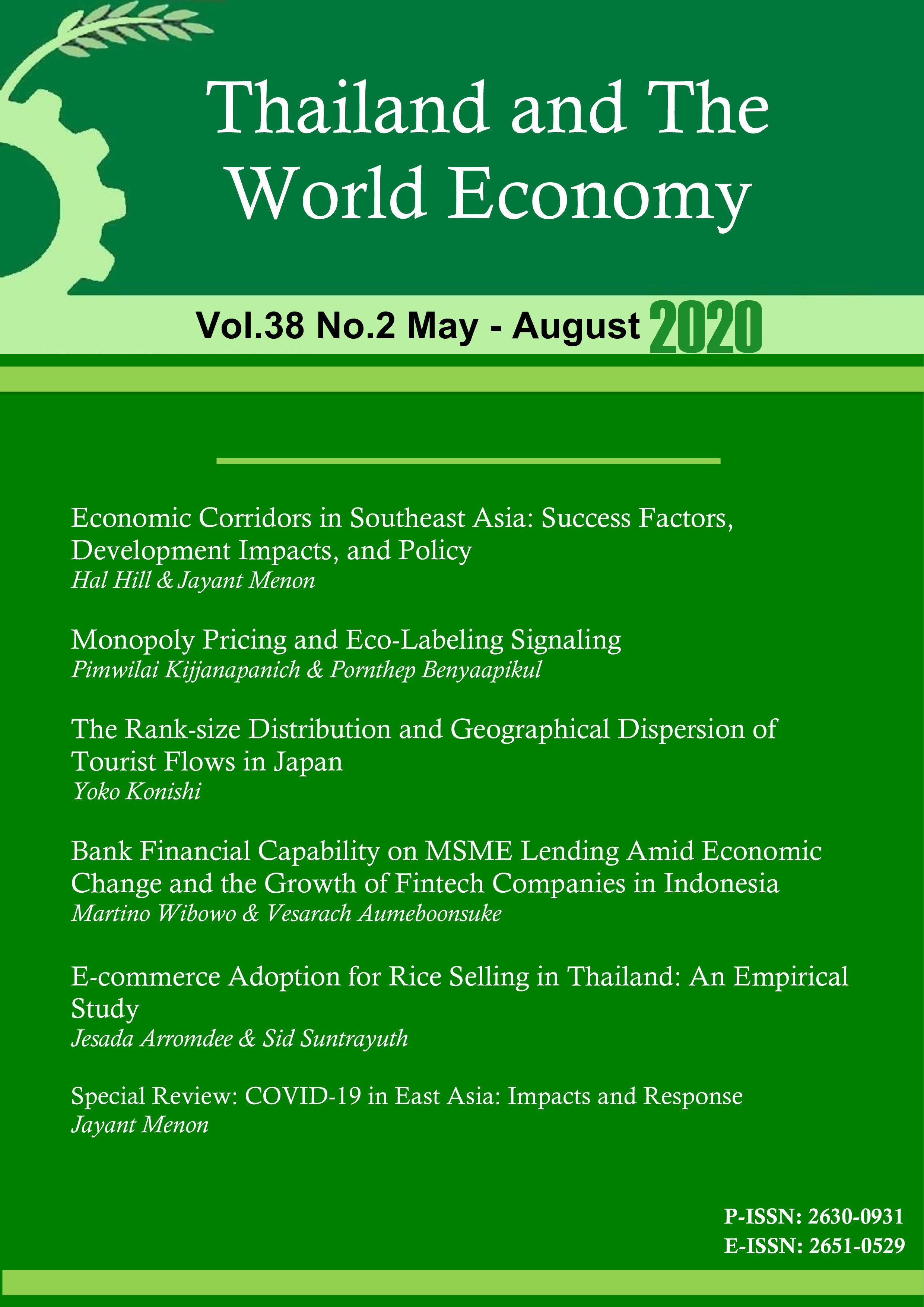Monopoly Pricing and Eco-labeling Signaling
Keywords:
eco-label, quality signaling, monopoly, credence goodsAbstract
Environmental friendly products are one kind of credence goods which is impossible to observe its ‘ethical quality’. It is difficult for consumers to distinguish between ethical and conventional firms. Then an eco-label from a third-party certifier is suspected to be an effective ethical quality signal that develops consumer trusts. This study, a monopoly signaling game, aims to find the firm equilibrium prices. It also objects to obtain the necessary conditions that make the eco-certification effective, under the conditions that conventional goods may be labeled and eco-friendly goods sometimes fail to be labeled. The results show that although prices fail to signal ethical quality in this case, an eco-label can be an indication of ethical characteristic. Namely, separating equilibrium which only an eco-friendly firm asks for label exists when an application cost is sufficiently high and the accuracy of labeling is large enough.In contrast, when the application fee is low, both types of firm may want to compete for a label.
References
Anania, G., & Nisticò, R. (2004). Public regulation as a substitute for trust in quality food markets: what if the trust substitute cannot be fully trusted? Journal of Institutional and Theoretical Economics JITE, 160(4), 681-701.
Atkinson, L., & Kim, Y. (2015). “I drink it anyway and I know I shouldn't”: Understanding green consumers' positive evaluations of norm-violating non-green products and misleading green advertising. Environmental Communication, 9(1), 37-57.
Auriol, E., & Schilizzi, S. G. (2003). Quality signaling through certification. Theory and an application to agricultural seed markets., IDEI working paper No. 165. Toulouse . Institut d’Economie Industrielle.
Baltzer, K. (2012). Standards vs. labels with imperfect competition and asymmetric information. Economics Letters, 114(1), 61-63.
Bonroy, O., & Constantatos, C. (2008). On the use of labels in credence goods markets. Journal of Regulatory Economics, 33(3), 237-252.
Bottega, L., & De Freitas, J. (2009). Public, private and nonprofit regulation for environmental quality. Journal of Economics & Management Strategy, 18(1), 105-123.
Bottega, L., & De Freitas, J. (2013). Imperfect Eco-labeling Signal in a Bertrand Duopoly. DEA Working Papers No. 62, Universitat de les Illes Balears, Departament d'Economía Aplicada.
Cherian, J., & Jacob, J. (2012). Green marketing: A study of consumers’ attitude towards environment friendly products. Asían social science, 8(12), 117.
Dahm, M. J., Samonte, A. V., & Shows, A. R. (2009). Organic foods: Do eco-friendly attitudes predict eco-friendly behaviors? Journal of American College Health, 58(3), 195-202.
De, S., & Nabar, P. (1991). Economic implications of imperfect quality certification. Economics Letters, 37(4), 333-337.
Du, Q. & Nguyen, Q. (2010). Effectiveness of eco-label? : A study of Swedish university students & apos; Choice on ecological food (Dissertation). Retrieved from http://urn.kb.se/resolve?urn=urn:nbn:se:umu:diva-34951
Fanelli, D. (2008). A two-stage duopoly game with ethical labeling and price competition when consumers differ in preferences. MPRA Paper No. 11544, University Library of Munich.
Giannakas, K. (2002). Information asymmetries and consumption decisions in organic food product markets. Canadian Journal of Agricultural Economics/Revue Canadienne D'Agroeconomie, 50(1), 35-50.
Grover, C., & Bansal, S. (2015). Eco-labelling under imperfect certification: An economic analysis.Retrieved from https://pdfs.semanticscholar.org/335e/3 02645403dcf16c1be27df03cb0c6136aa07.pdf?_ga=2.116004677.2115585392.1584665711-213182767.1584665711
Ibanez, L., & Grolleau, G. (2008). Can ecolabeling schemes preserve the environment? Environmental and Resource Economics, 40(2), 233-249.
Ibanez, L., & Stenger, A. (2000). Environment and food safety in agriculture: Are labels efficient? Australian Economic Papers, 39(4), 452-464.
Mason, C. F. (2006). An economic model of ecolabeling. Environmental Modeling and assessment, 11(2), 131-143.
Mason, C. F. (2011). Eco-labeling and market equilibria with noisy certification tests. Environmental and Resource Economics, 48(4), 537-560.
McCluskey, J. J. (2000). A game theoretic approach to organic foods: An analysis of asymmetric information and policy. Agricultural and Resource Economics Review, 29(1), 1-9.
Nelson, P. (1970). Information and consumer behavior. Journal of political economy, 78(2), 311-329.
Nimon, W., & Beghin, J. (1999). Ecolabels and international trade in the textile and apparel market. American Journal of Agricultural Economics, 81(5), 1078-1083. Paço, A., Alves, H., & Shiel, C. (2013). Development of a green consumer behaviour model. International Journal of Consumer Studies, 37(4), 414-421.
Pavlinović, S. (2013). Environmentally friendly production and labelling. Management: journal of contemporary management issues, 18(2), 21-35.
Prakash, A. (2002). Green marketing, public policy and managerial strategies.
Business Strategy and the Environment, 11(5), 285-297.
Strausz, R. (2010). Separating eequilibria with imperfect certification: SFB/TR 15 Discussion Paper No. 324, Free University of Berlin, Humboldt University of Berlin, University of Bonn, University of Mannheim, University of Munich.
Zago, A. M., & Pick, D. (2004). Labeling policies in food markets: Private incentives, public intervention, and welfare effects. Journal of Agricultural and Resource Economics 29(1), 150-165.










